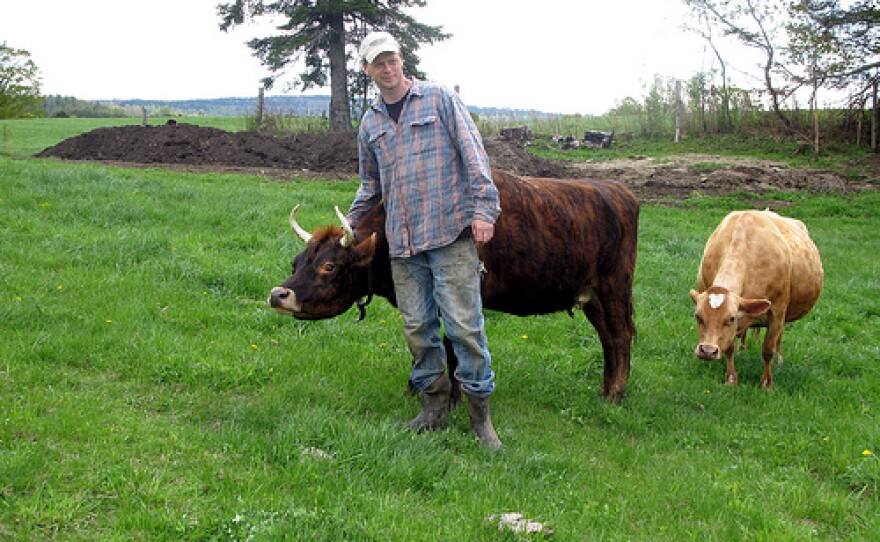In the conversations around localism, one Northern New England town has received a lot of attention.
A few years back, Hardwick, Vermont made national headlines as the poster child for the local food movement.
The town had been struggling with a median income 25 percent below the state average.
Its unemployment rate was 40 percent higher.
As part of our food series, Eating-in, NHPR’s Keith Shields brings you the story of a town saved by an agricultural uprising.
The name alone can tell you something about the town.
Hard-wick, Vermont... a onetime hard-nosed, hardscrabble former Granite town situated at the southern gateway to Vermont’s Northeast kingdom.
Back at the turn of the last century, Hardwick was the largest producer of building grade granite in the world.
But when the granite industry dried up in the nineteen twenties, agriculture moved in.
The town struggled for decades.
But about 10 years ago, new blood entered the town’s veins.
Ben Hewitt calls them agripreneurs.
“it was a handful of businesses based on food or agriculture that to my eyes were applying a deeper degree of business acumen in the sense in which they were more marketing savvy, a lot of cases producing value added products.
Hewitt wrote the book, The Town that Food Saved
….. they were looking to make products that would by and large be shipped out of the region but would hopefully produce that economic viability to allow them to build a network of businesses that could create jobs and economic development in the more traditional sense. :32
And so it was sort of a perfect storm of cheap farmable land and forward thinking that turned Hardwick around.
Today, the town of over three thousand and its surrounding communities, boast a large organic seed company, several successful vegetable and dairy farms, one of the country’s longest continuously running food co-ops, a large composting facility, and even a tofu and soy milk plant called Vermont Soy.
Andrew Meyer is a partner of Vermont Soy.
He says the success of these businesses is not measured in the number of local residents eating tofu for lunch.
…… It’s how many jobs did that job tofu factory create? How many farmers did we buy from? How many farmers were able to benefit by adding more cash to their farm and how many people are more connected to where there food came from? And as you put all those together you strengthen the community and as your strengthen the community, you strengthen their ability and knowledge and want to spend their money here”
Over the last five years, these local businesses have created an estimated 100 jobs.
But the town isn’t in the clear yet.
Unemployment remains high, wages remain low and most residents still buy their food at the local Grand Union supermarket.
Author Ben Hewitt: The state of Vermont per capita spend about $35 dollars a year on Vermont produced food which is to me seems pitifully low but its also from what I understand three times higher than the next best state which is Maine. So the impact of this stuff is tremendous. If we can get people spending even 10 or 20 percent of their food budget on local agriculture, that’s money that stays in the community to support the local citizenry and local businesses.
Business leaders meet regularly to discuss the next step for Hardwick.
An informal sustainable business network shares ideas, and even money between local agriprenuers.
Tom Gilbert is the Executive Director for the Highfield Center for Composting in Hardwick.
“…We have a lot of aspirations as a community. We have a lot of things in place. We have a very very intact food system all things being equal but it’s not resolved. We are not ready to be a class room we are still a lab. And I think there is this main question of how do you produce a high quality product, pay people fairly for their work, and build a productivity of the environment if not at the very least mitigate problems with it and still keep food accessible.
Chambers of commerce across the country have contacted business leaders in town and asked how they can create a Hardwick of their own.
And so what’s somewhat ironic about Hardwick is that its chief commodity may not be its dairy or soy or seeds.
It may be something they can’t package … inspiration.
Author Ben Hewitt: If people can take from this a measure of wanting to get involved in their community and being inspired to take the steps that are necessary to make this happen in their community... I really do think in a lot of ways that is probably the most valuable thing that can come from this.
Link:






